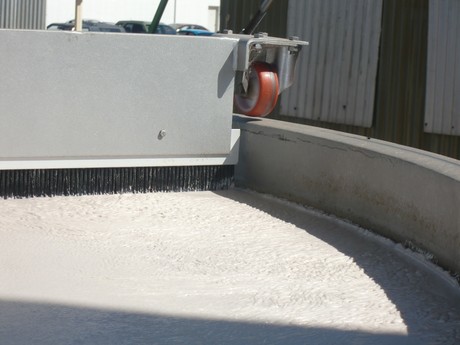Flotation cell for fat recovery featuring at foodpro

Wastewater treatment specialist CST Wastewater Solutions is coming to foodpro, bringing with it a highly effective flotation cell that enables fats and solids recovery in high-temperature applications.
The company’s induced air flotation (IAF) technology — to be featured on Stand S9 — is an advance on the currently used flotation technology for industrial applications, dissolved air flotation (DAF). DAF is a treatment method for industrial wastewater effluent produced by food, beverage and primary processing plants.
“DAF’s great strengths as a primary treatment include relative simplicity in installation and proven cost-efficiency in separating oil and suspended solids from wastewater in applications as diverse as dairy, beef, pork, poultry, grains, cereals and crops such as beets, cassava, potatoes, soy, wheat, corn and sugar cane,” said CST Wastewater Solutions Managing Director Michael Bambridge.
“Compact and robust DAF systems achieve environmental sustainability by reducing chemical oxygen demand (COD) loading by the removal of high COD contaminants including fats, oils and greases, colour, organic matter and colloidal material.
“However, in high-temperature applications (ie, wastewater above 80°C), DAF has a number of limitations, including: the solubility of air is very low, so very high recycle ratios are required; cavitation is a problem in recycle pumps; higher saturator pressure is required; large cells are needed to accommodate increased recycle flow.”
CST Wastewater Solutions overcame these problems by introducing an energy-efficient IAF high-temperature cell to provide a different method of introducing pressurised air into the flotation process. The flotation cell is based on a multistage separation process, with an innovative internal launder to ensure the float product produced from the cell remains at the same temperature as the liquid, so as to facilitate sludge transfer.
The cell uses a spinning disk to provide pressurised air for vortex bubble formation in the volumes required in high-temperature applications. By generating bubbles at temperatures above 80°C — the usual limit for DAF systems — “this opens up the potential for new levels of efficiency in high-temperature applications, which also benefit from reduced energy consumption”, said Bambridge. Such applications include:
- treatment of high-temperature rendering waste in meat works;
- clean in place (CIP) wastewater in food factories;
- quenching liquors in coke ovens applications;
- oil and grease removal from hot solutions, such as rolling mills.
“By eliminating bubble solubility issues at higher temperatures — including removing the need for higher pressures and larger cells — the new design is energy-efficient and sustainable over the longer term, as well as highly effective immediately upon installation in oil-water separation at elevated temperatures,” said Bambridge.
Bambridge will be on hand at FoodPro, to be held at ICC Sydney from 16–19 July, to answer further questions about the technology.
Smith & Loveless acquires CST Wastewater Solutions
The two wastewater technology companies have worked in partnership on projects throughout...
Chemical dosing tech to combat sulfide smell in sewers
Dr Jiuling Li has developed an award-winning, real-time control and chemical dosing technology to...
Using pure oxygen to treat wastewater
Barwon Water's new Green Oxygen for Wastewater Treatment project has secured up to $3 million...







